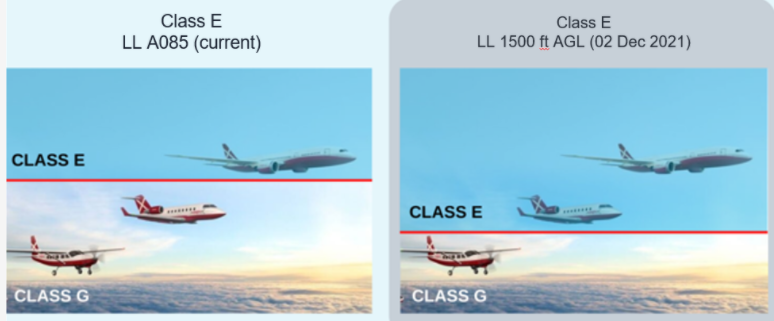Airservices Australia is proposing to lower the base of Class E airspace to 1,500ft (AGL) in medium and high density enroute airspace between Cairns and Melbourne in December 2021. The proposal is part of Airservices’ Airspace Modernisation Program (AMP) to reform Australia’s airspace architecture to ensure the class of airspace is aligned with the assessed level of risk, to leverage the benefits of increased ADS-B coverage, to reduce complexity.
The Australian Association for Unmanned Systems (AAUS) seeks responses to the proposal to lower Class E airspace along the East Coast by 25 February 2021.
AAUS considers this is a significant change to airspace. Airservices’ proposed timeline is considered aggressive and consequently, there is broad industry concern that the necessary assessments and considerations will be rushed. AAUS has recently become aware of this proposal and is currently engaging with its membership and the broader RPAS / AAM industry. We seek consideration to submit further and more comprehensive input by February 26, says the association.
AAUS is interested in the safe and viable operations of RPA and AAM in integrated airspace. We are in the process of engaging with the RPA / AAM industry to identify potential implications including those relating to operational safety and airspace accessibility as well as potential economic impacts associated with the proposal to lower Class E airspace along the East Coast. Fair access to airspace above 400 ft will become increasingly important to the RPA and AAM industry. There are also potential safety benefits to the proposal in relation to enabling routine RPA / AAM operations in non-segregated airspace. However, this needs to be carefully balanced against introduced risks, in particular, those associated with the likely increased concentration of VFR and RPA operations below the proposed lower bound of Class E airspace. AAUS strongly advocates for a comprehensive safety assessment that considers the interplay of operations of all airspace users, and their changing needs, in the long term.
Consideration must be given to emerging sectors and associated operational use cases, in particular, RPAS and AAM operations. The program should provide a clear statement showing how it supports the long-term operational concept for Australian airspace with clear traceability to the strategic safety, efficiency, accessibility, and sustainability objectives such an operational concept should deliver.
Over the coming years, Airservices will change the service provision at 15 regional airports and across thousands of miles of low level airspace as part of the Airspace Modernisation Program (AMP). Benefiting the entire east coast and regional Australia, they plan on leveraging ADS-B and radar surveillance assets to enhance service delivery. The purpose of the AMP is to reform Australia’s airspace architecture to ensure the class of airspace is aligned with the assessed level of risk, to leverage the benefits of increased ADS-B coverage, to reduce complexity and to contribute to the OneSKY Benefit Delivery.
AAUS seeks responses: https://aaus.org.au/class-e-survey/
For more information visit:




